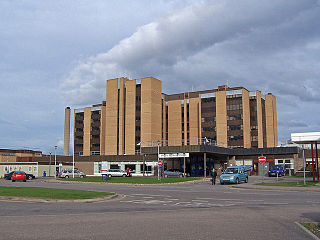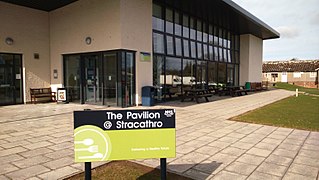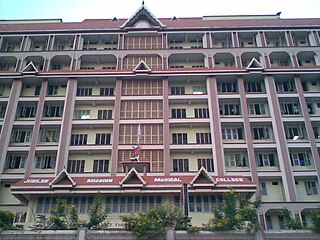Related Research Articles

An emergency department (ED), also known as an accident and emergency department (A&E), emergency room (ER), emergency ward (EW) or casualty department, is a medical treatment facility specializing in emergency medicine, the acute care of patients who present without prior appointment; either by their own means or by that of an ambulance. The emergency department is usually found in a hospital or other primary care center.

Raigmore Hospital is a health facility located in Inverness, Scotland. It serves patients from the local area as well as providing specialist services to patients from across the Highland area. It is a teaching hospital, educating a range of healthcare professionals in association with the Universities of Aberdeen and Stirling. It is managed by NHS Highland.

Netcare Limited is a South African private healthcare company. It operates through a number of subsidiaries and employs just over 21 000 people.

NHS Scotland, sometimes styled NHSScotland, is the publicly funded healthcare system in Scotland and one of the four systems that make up the National Health Service in the United Kingdom. It operates 14 territorial NHS boards across Scotland, 7 special non-geographic health boards, and NHS Health Scotland.

University Hospital Hairmyres is a district general hospital in the Hairmyres neighbourhood of East Kilbride, South Lanarkshire, Scotland. The hospital serves one of the largest elderly populations in Scotland. It is managed by NHS Lanarkshire.

Stracathro is a small place in Angus, Scotland. It was the site of a Roman marching camp as their forces invaded to the north.

Stobhill Hospital is an Ambulatory Care and Diagnostic Hospital, located in Springburn in the north of Glasgow, Scotland. It serves the population of North Glasgow and part of East Dunbartonshire. It is managed by NHS Greater Glasgow and Clyde.
Hospital emergency codes are coded messages often announced over a public address system of a hospital to alert staff to various classes of on-site emergencies. The use of codes is intended to convey essential information quickly and with minimal misunderstanding to staff while preventing stress and panic among visitors to the hospital. Such codes are sometimes posted on placards throughout the hospital or are printed on employee identification badges for ready reference.

Bangour Village Hospital was a psychiatric hospital located west of Dechmont in West Lothian, Scotland. During the First World War it formed part of the much larger Edinburgh War Hospital.

Middlemore Hospital is a major public hospital in the suburb of Otahuhu, Auckland, New Zealand. The hospital has approximately 800 beds. There are 24 operating theatres across two sites.
Healthcare in Brazil is a constitutional right. It is provided by both private and government institutions. The Health Minister administers national health policy. Primary healthcare remains the responsibility of the federal government, elements of which are overseen by individual states. Public healthcare is provided to all Brazilian permanent residents and foreigners in Brazilian territory through the National Healthcare System, known as the Unified Health System. The SUS is universal and free for everyone.

St John's Hospital is the main general hospital in Livingston, West Lothian, Scotland. Located in the Howden area of the town, it serves Livingston and the wider West Lothian region. St John's is a teaching hospital for the University of Edinburgh Medical School. It is managed by NHS Lothian.
Bangour General Hospital was a hospital just west of the village of Dechmont, West Lothian, Scotland. It had its origins during the Second World War when hospital bed numbers in Scotland were greatly expanded to deal with the anticipated increase in civilian and military war casualties. The Emergency Hospital Service (Scotland) scheme resulted in seven new hospitals being built, while at Bangour Village Hospital in West Lothian an annexe of five ward blocks was built and this developed into Bangour General Hospital after the war. This hospital served the population of West Lothian as a general hospital and also included a maxillo-facial unit serving the Lothian region and a burns and plastic surgery unit serving much of east Scotland, the Borders and the Highland region. The hospital services were transferred to the newly built St John's Hospital at Livingston during 1989–90, and Bangour General Hospital closed in 1990 and was subsequently demolished.

The Regional Institute of Medical Sciences (RIMS) was established on 14 September 1972 in the name of the Regional Medical College. It is situated in a locality at Lamphelpat in Manipur, India. It is run by a society named "North Eastern Regional Medical College Society" which was duly registered under the Manipur Societies Registration Act, 1989.
NHS Scotland is the publicly funded healthcare systems in Scotland. It was founded by the National Health Service (Scotland) Act 1947 and was launched on 5 July 1948, under the control of the Secretary of State for Scotland. As a result of the Scotland Act 1998, control over NHS Scotland transferred to the Scottish Government and Parliament in 1999.

Stracathro Hospital is a community hospital in Angus, Scotland. Established as a wartime Emergency Hospital Service facility during the Second World War, it was afterward developed as a District General Hospital. Since 2005 it has been the site of the Scottish Regional Treatment Centre.

Jubilee Mission Medical College and Research Institute is a private, non-profit Christian minority medical college, hospital and research institute located at Thrissur in Kerala, India. The establishment is administered by the Jubilee Mission Hospital Trust, a charitable organisation under the Catholic Archdiocese of Thrissur.
During World War II, a centralised state-run Emergency Hospital Service was established in the United Kingdom. It employed doctors and nurses to care for those injured by enemy action and arrange for their treatment across the range of local and charity hospitals that existed at that time. It was also known as the Emergency Medical Service, although this was, strictly speaking, the medical staff of the service.

The Queen Elizabeth University Hospital (QEUH) is a 1,677-bed acute hospital located in Govan, in the south-west of Glasgow, Scotland. The hospital is built on the site of the former Southern General Hospital and opened at the end of April 2015. The hospital comprises a 1,109-bed adult hospital, a 256-bed children's hospital and two major Emergency Departments; one for adults and one for children. There is also an Immediate Assessment Unit for local GPs and out-of-hours services, to send patients directly, without having to be processed through the Emergency Department.
The Arran War Memorial Hospital is a healthcare facility located in Lamlash on the Isle of Arran, Scotland. It has seventeen staffed beds for in-patient medical care, x-ray facilities, and is the base for a community maternity unit. It is managed by NHS Ayrshire and Arran.
References
- ↑ "National Health Service: Emergency Scheme's Success". The Glasgow Herald . 31 July 1942. p. 2. Retrieved 29 March 2016.
- ↑ "Scottish Medical Services in Wartime:Emergency Facilities Now Permanent". The Glasgow Herald. 9 July 1953. p. 9. Retrieved 29 March 2016.